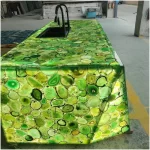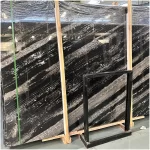Uncovering the Beauty of White Serpeggiante Marble: A Professional Guide
Marble has been used as a building material since ancient times, and its timeless beauty and durability continue to make it a popular choice in modern architecture and design. Among the many types of marble available, White Serpeggiante Marble stands out for its unique pattern and coloration, which make it a favorite of architects, interior designers, and homeowners alike. In this professional guide, we will explore the beauty of White Serpeggiante Marble, its properties, applications, care and maintenance, as well as sustainability and ethical considerations.
Introduction
White Serpeggiante Marble is a type of natural stone that is quarried in Italy. It is known for its greyish-white background and sinuous veins that range in color from light grey to dark brown. The word “serpeggiante” in Italian means “snakelike” or “winding,” which aptly describes the appearance of this marble. The beauty and elegance of White Serpeggiante Marble have made it a popular choice in high-end projects, including residential and commercial buildings, hotels, and public spaces.
The significance of understanding its properties and characteristics
Before using White Serpeggiante Marble from China in any design project, it is important to understand its properties and characteristics. Like all natural stones, White Serpeggiante Marble has variations in color, pattern, and veining, which can affect its appearance and durability. By understanding these variations, architects and designers can select the right type of marble for their specific needs and avoid costly mistakes.
Properties of White Serpeggiante Marble
The composition and geological formation of White Serpeggiante Marble
White Serpeggiante Marble is a metamorphic rock that is formed from limestone that has been subjected to high pressure and heat over millions of years. The resulting rock is made up of interlocking crystals of calcite or dolomite, which give it its distinctive hardness and durability. The composition of White Serpeggiante Marble also includes other minerals such as mica, quartz, and feldspar, which contribute to its unique coloration and veining.
The unique patterns and veins that make it so desirable
One of the most distinctive features of White Serpeggiante Marble in China is its sinuous veins, which meander across its surface like a river. The veins range in color from light grey to dark brown and can create a variety of patterns, from subtle to bold. The veins are formed by the presence of mineral deposits that were present during the formation of the marble. No two slabs of White Serpeggiante Marble are exactly alike, which adds to its appeal and uniqueness.
The different types and finishes of White Serpeggiante Marble
White Serpeggiante Marble from China is available in a variety of types and finishes, each with its own distinct characteristics. The most common types of White Serpeggiante Marble are Carrara, Calacatta, and Statuario. Carrara is the most widely used type of White Serpeggiante Marble and is known for its greyish-white background and fine veins. Calacatta has a more pronounced veining and a whiter background than Carrara, while Statuario has a more dramatic veining pattern and a brighter white background.
White Serpeggiante Marble has a slightly rough texture that highlights its natural beauty and is ideal for creating a rustic or industrial look. Tumbled White Serpeggiante Marble has a weathered, antique look that is created by tumbling the marble tiles with stones and abrasive materials.
Applications of White Serpeggiante Marble
White Serpeggiante Marble is a versatile material that can be used in a variety of applications, both indoors and outdoors. Its unique beauty and durability make it a popular choice for high-end projects, including:
-
Flooring: White Serpeggiante Marble is often used as flooring in residential and commercial buildings. Its natural beauty and durability make it ideal for high-traffic areas, such as foyers, hallways, and bathrooms.
-
Wall Cladding: White Serpeggiante Marble can also be used as wall cladding, either as a full-wall covering or as an accent. Its sinuous veins and patterns create a striking visual effect that can enhance the beauty of any room.
-
Countertops: White Serpeggiante Marble is a popular choice for kitchen and bathroom countertops. Its hardness and resistance to heat and moisture make it ideal for these applications.
-
Staircases: White Serpeggiante Marble can be used to create elegant and durable staircases in both residential and commercial buildings.
Care and Maintenance of White Serpeggiante Marble
Like all natural stones, White Serpeggiante Marble requires proper care and maintenance to maintain its beauty and durability. Here are some tips for caring for your White Serpeggiante Marble:
-
Clean up spills immediately: White Serpeggiante Marble is susceptible to staining from liquids such as wine, coffee, and acidic substances. Clean up spills immediately to prevent them from penetrating the surface of the marble.
-
Use a pH-neutral cleaner: Avoid using harsh or acidic cleaners on White Serpeggiante Marble. Use a pH-neutral cleaner specifically designed for natural stone.
-
Seal the marble: Sealing White Serpeggiante Marble can help prevent staining and etching. Seal the marble every 6-12 months, depending on the level of use.
-
Avoid abrasive cleaners and scrubbers: Avoid using abrasive cleaners or scrubbers on White Serpeggiante Marble, as they can scratch the surface of the marble.
Sustainability and Ethical Considerations
White Serpeggiante Marble is a natural stone that is quarried from the earth. As such, there are sustainability and ethical considerations that should be taken into account when using this material in design projects.
-
Sustainable sourcing: It is important to source White Serpeggiante Marble from quarries that follow sustainable practices, such as minimizing waste and using renewable energy sources.
-
Ethical labor practices: It is also important to ensure that the workers in the quarries and factories that produce White Serpeggiante Marble are treated fairly and have safe working conditions.
Conclusion
In conclusion, White Serpeggiante Marble is a beautiful and versatile natural stone that can add elegance and sophistication to any design project. Its unique patterns and veins, combined with its durability and resistance to heat and moisture, make it a popular choice for high-end projects. By understanding its properties, applications, care and maintenance, and sustainability and ethical considerations, architects and designers can make informed decisions when using White Serpeggiante Marble in their projects.
Related Products









